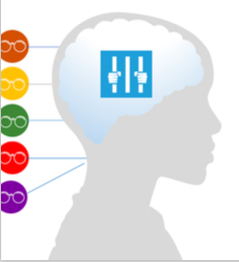
A major stumbling block to growth for organizations lies in their cognitive constraints. In other words, there are mental models, or, more simply, limiting beliefs that prevent us from seeing solutions.
In the Decalogue approach, we have worked over the last 20 years with hundreds of top and middle managers to build custom made implementations of the Decalogue and the starting point has always been to dig up, challenge and break through their limiting beliefs.
We do this using the powerful Thinking Process tool called the Core Conflict Cloud. A group of managers sits for two-three days in a room starting with a “bitching and moaning” session where all their Undesirable Effects (UDEs) are verbalized. This first phase is a very “feel good” one, everybody agrees that the company is plagued by these effects. These effects are and feel “real” and everybody would like to get rid of them.
Summarizing all the Undesirable Effects (UDEs) in one single statement is normally a little cumbersome but it is generally done in few hours. The end result is normally welcomed as a breakthrough. How does that happen?
Crafting the breakthrough
The Conflict Cloud helps to sharpen our intuition. The group of managers in just a few days has moved from an often disparate set of non-verbalized hunches to a clear cut picture of the forces that keep them from achieving their goal. Moreover, a precise description of the needs that craft the psyche of the organization goes a long way in helping to understand the “why” we are trapped in this conflict, the reason for it. No top management strategic retreat session delivers a tangible and operational output like this one. Now that the intuition is strong we can make it stronger.
What transforms a core conflict into a full-blown picture of our current reality is a disciplined, orderly elucidation of all the mental models that give birth to the conflict. These mental models are deeply rooted images that we have of ourselves and the world around us. We may also call these mental models “assumptions” . They are the cognitive lenses through which we perceive reality.
Assumptions are, like any other mental construction, the result of external (the environment, education, experiences, values, etc.) and internal (the chemistry and physics of our mind) factors. The difference between an assumption and a statement of reality is only the realm of validity, determined often by cultural circumstances. (If you want a practical example of this last statement, take a sentence like “in a democracy every citizen is entitled to decent, affordable and reliable healthcare” and ask for a comment from a statistically representative sample of individuals in the US, Canada, and Europe).
We must never be slaves to our assumptions. They must be challenged so we can find ways ahead. The Core Conflict Cloud, when correctly used, allows us to engineer into our organizations not just continuous improvement, but continuous innovation.
Sign up to our blog here and shift your thinking towards broader, systemic possibilities for yourself and your organization. Intelligent Management provides education and training on systemic management, W. Edwards Deming’s management philosophy and the Theory of Constraints (Decalogue methodology) in North America and Europe.
About the Blog Author and Editor
Angela Montgomery Ph.D. is Partner and Co-founder of Intelligent Management and author of the business novel+ website The Human Constraint that has sold in over 20 countries. She is co-author with Dr. Domenico Lepore, founder, and Dr. Giovanni Siepe of ‘Quality, Involvement, Flow: The Systemic Organization’ from CRC Press, New York.





Your Core Conflict Cloud gave me associations to World Peace Game, https://worldpeacegame.org/
I think its very good approach to place decision-makers in the situation where they can describe intangibles, the implicit to become explicit. This process can sometimes hurt but ones gone through it and understand its not personal but systemic contribution, this will grow humans.